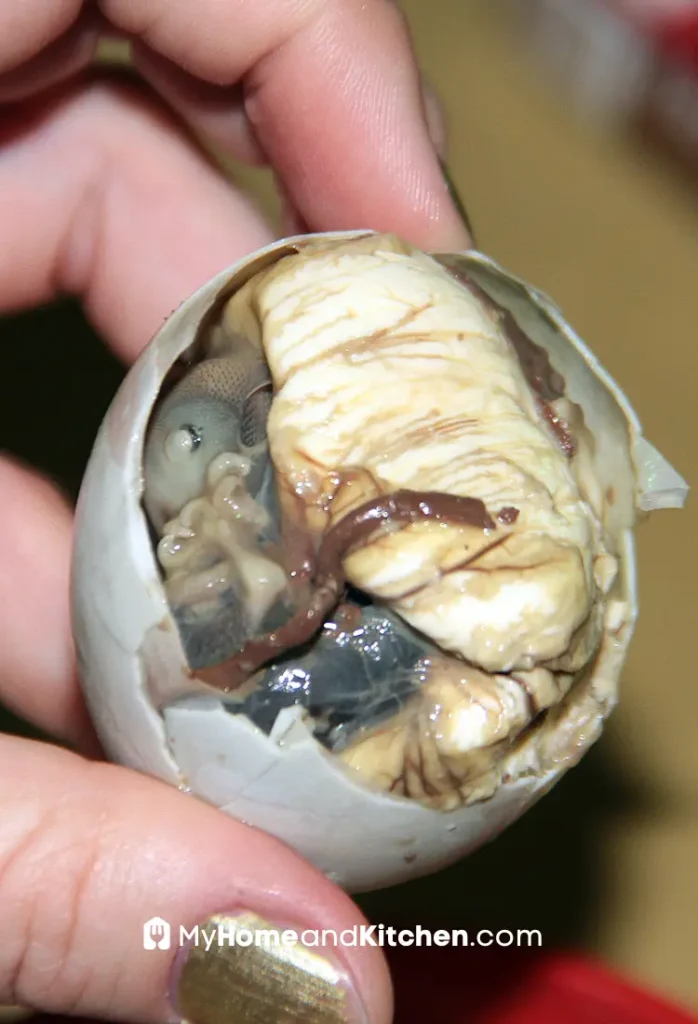Join Our Newsletter for Cozy Home Inspiration, Family Fun, and Delicious Recipes Every Week
How to Cook Balut
A controversial Filipino delicacy that a lot of people, even citizens of its origin country, frown upon but once tasted, it’s a real delight. Balut is made from fertilized duck or chicken eggs that are in the process of developing their embryo.
Balut has a subtle savory flavor and fermented undertones due to the eggs being incubated for about 14 to 21 days before they’re steamed. The juice of the egg is akin to watered-down chicken broth and the yolk has a creamy texture that’s similar to the taste of a fishy custard.

In some regions, such as Singapore, balut is considered illegal and is banned from sales and importation because they emphasize the importance of animal health and product safety. In a way, it is an exotic dish since it contains a half-developed egg embryo making it forbidden.
How To Cook Balut?
The following steps are how you cook balut the traditional Filipino way:
- Clean and wash the duck or chicken eggs thoroughly in running water.
- In a large pot, put 3 cups of water and bring to a boil. Add a pinch of salt or more if necessary.
- Crack each egg and place it into a small bowl.
- Place an egg into the boiling salt-water mixture and let it boil for 10 minutes.
- Use a slotted spoon to remove the egg from the pot and place on top of paper towels to drain properly. Repeat the same process with the other eggs.
You can also opt to boil the eggs for 20 to 30 minutes if you want them hard-cooked, but you would have to place the eggs in cold water shortly to fully stop the cooking process. Other than boiling, balut can also be enjoyed fried, as a filling, or cooked adobo-style.
What Is The Difference Between Balut Eggs and Regular Eggs?
Both eggs are hard or soft-boiled the same way but when making balut, the liquid inside the egg will turn into a broth-like consistency instead of solidifying. That substance then simmers the duck or chicken fetus and then the yolk.
How Long Will Balut Last?
Balut should be consumed immediately within the day because it is highly perishable. For storing, It is state-recommended to refrigerate cooked balut eggs immediately at below 40°F temperature. This way, the shelf life of the balut will last about 1 week.
Uncooked balut, on the other hand, will last for 2 weeks in the refrigerator. It can also be frozen for up to 1 month as long as it’s wrapped in an air-tight container or heavy-duty plastic wrap.
How To Tell If Balut Has Gone Bad?
The simple trick is to let it sit on water. If it floats, it has already spoiled because the air inside the egg expands at all angles as it ages, increasing its buoyancy. If the eggs sink to the bottom of the water, they’re still edible but if they stand upright then they have gone bad.
Where To Buy Balut?
Farmers’ markets in the US sell these Filipino delights. In the Philippines, it can virtually be found anywhere even in local communities, and is usually sold at night. Street vendors will usually line up the streets and sell their balut eggs on a large bike with boiling equipment ready at hand.
How To Eat Balut?
The following guide will help you eat balut the traditional Filipino way the next time you see it being sold by a street vendor or when you’re trying to cook some at home yourself:
- Crack the eggshell on top and create a small enough opening for your mouth. To fully enjoy the egg, don’t let any of the juices spill out.
- Sprinkle a bit of salt, vinegar, soy sauce, chili garlic or your choice of seasoning into the opening then slurp up the broth. In Vietnam, it is seasoned with the classic salt and pepper combo and Vietnamese Coriander (similar to cilantro).
- Peel the eggshell then eat the actual egg meat inside. The yolk doesn’t taste that different from a regular egg but it does have a creamy texture. The chick part is a crowd favorite and, depending on how long the egg was incubated, it may have a bit of a crunchy texture.
- The bato (stone) or balut white can be thrown away if it tastes too unpleasant or is too tough to chew.
Can Balut Be Eaten Raw?
No, because raw balut is only cooked or boiled briefly which increases the risk of spoilage and the growth of potentially harmful microorganisms just like any other egg. Generally, it is unfit for human consumption, however, some countries will serve it raw but it’s not a common thing.
Is Balut Good For Your Health?
Balut eggs are good sources of protein in Southeast Asia. They also have powerful antioxidants of Vitamin C and beta carotene that help clean the bloodstream and support immune systems. Although not scientifically proven, balut is claimed to have a natural aphrodisiac effect that increases libido.
Moreover, balut also has riboflavin, thiamine, and niacin which helps in metabolizing energy and regulating cell and organ function.
Refer to the table below for more of the nutritional information balut has:
| Nutrition | Total Amount per 1 egg (102 grams) | Percentage of Daily Value (DV) based on a 2000-calorie diet |
| Calories | 188 | 9% |
| Saturated Fat | 3.7 grams | 19% |
| Protein | 13 grams | 26% |
| Carbohydrates | 1.5 grams | 1% |
| Cholesterol | 897 milligrams | 299% |
| Iron | 4 milligrams | 15% |
| Sodium | 148 grams | 6% |
| Potassium | 225 milligrams | 6% |
| Calcium | 78 milligrams | 6% |
Other health benefits of eating balut are promoting weight loss, helping prevent cancer, preventing premature aging, improving bone density, and enhancing vision.
Why Should You Not Eat Balut?
Balut is perfectly safe to eat but does not meet health standards as it is a high-cholesterol food which can increase the risk of heart-related issues. If you’re someone who’s already at risk, then avoid overeating. Nonetheless, balut should still be consumed in moderation.
What To Serve With Balut?
Choosing dishes with balut will be similar to choosing regular hard or soft-boiled eggs. You can try grilled cheese sandwiches, salad, and potatoes (mashed, fried, or roasted). For drinks, soda or try a Filipino beverage called sago at gulaman which is made of water, brown sugar, tapioca pearls, and gelatin.
Other Food Storage Articles You May Be Interested In



